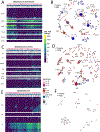Phage display of environmental protein toxins and virulence factors reveals the prevalence, persistence, and genetics of antibody responses
- PMID: 35649416
- PMCID: PMC9203978
- DOI: 10.1016/j.immuni.2022.05.002
Phage display of environmental protein toxins and virulence factors reveals the prevalence, persistence, and genetics of antibody responses
Abstract
Microbial exposures are crucial environmental factors that impact healthspan by sculpting the immune system and microbiota. Antibody profiling via Phage ImmunoPrecipitation Sequencing (PhIP-Seq) provides a high-throughput, cost-effective approach for detecting exposure and response to microbial protein products. We designed and constructed a library of 95,601 56-amino acid peptide tiles spanning 14,430 proteins with "toxin" or "virulence factor" keyword annotations. We used PhIP-Seq to profile the antibodies of ∼1,000 individuals against this "ToxScan" library. In addition to enumerating immunodominant antibody epitopes, we studied the age-dependent stability of the ToxScan profile and used a genome-wide association study to find that the MHC-II locus modulates bacterial epitope selection. We detected previously described anti-flagellin antibody responses in a Crohn's disease cohort and identified an association between anti-flagellin antibodies and juvenile dermatomyositis. PhIP-Seq with the ToxScan library is thus an effective tool for studying the environmental determinants of health and disease at cohort scale.
Keywords: Crohn's; ToxScan; antibody epitoe profiling; disease; humoral immunity; immunogenetics; juvenile dermatomyositis; microbiome.
Copyright © 2022 Elsevier Inc. All rights reserved.
Conflict of interest statement
Declaration of interests H.B.L. is an inventor on an issued patent (US20160320406A) filed by Brigham and Women’s Hospital that covers the use of the VirScan technology; is a founder of ImmuneID, Portal Bioscience, and Alchemab; and is an advisor to TScan Therapeutics. C.L.S. is supported for unrelated work by research grants from Janssen and Bristol Myers Squibb.
Figures






References
-
- Adamou JE, Heinrichs JH, Erwin AL, Walsh W, Gayle T, Dormitzer M, Dagan R, Brewah YA, Barren P, Lathigra R, Langermann S, Koenig S, Johnson S, 2001. Identification and Characterization of a Novel Family of Pneumococcal Proteins That Are Protective against Sepsis. Infect. Immun 69, 949–958. 10.1128/IAI.69.2.949-958.2001 - DOI - PMC - PubMed
Publication types
MeSH terms
Substances
Grants and funding
LinkOut - more resources
Full Text Sources
Research Materials
Miscellaneous

